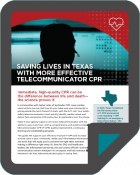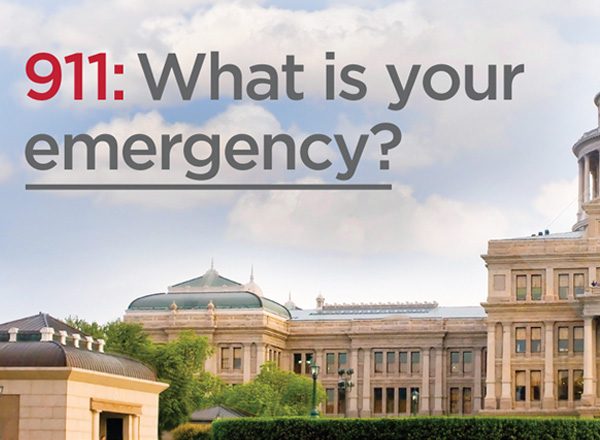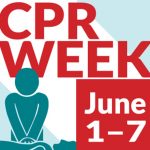Lawmakers in Texas are taking steps to help 911 and EMS professionals save more lives. Texas recently passed House Bill 786, which ensures all Texas 911 dispatchers are trained in the delivery of high-quality T-CPR.1
Telecommunicator-CPR is the process by which a 911 dispatcher coaches a caller through the process of bystander CPR while first responders are on their way. In the case of sudden cardiac arrest, dispatcher-assisted CPR is crucial and triples the chance of survival.
Currently, not all dispatchers in the United States are able to coach CPR over the phone to callers in need. This new law will close a critical gap in Texas, ensuring that 911 dispatchers get the training they need to have the skills and confidence needed to direct callers to save a life by immediately starting CPR. With this legislation, Texas joins more than 9 states across the nation that have identified the powerful impact that telecommunicator CPR can have in saving lives.
Download our checklist and guide for implementing more effective Telecommunicator CPR in your 911 system
Let’s Look at the Numbers
More than 350,000 people experience out-of-hospital cardiac arrest (OHCA) in the country each year. Across the United States, only 10.8% of those victims survive. In Texas, that number might be even lower: The Texas-CARES Program reports that of the estimated 22,000 people who suffer a cardiac arrest each year across the state, as few as 5% survive.2
This estimate means that nearly 21,000 people die from cardiac arrest in Texas each year, a number that scientific studies prove could be significantly reduced with telecommunicator CPR instructions.
What Do the Experts Say?
The consensus among cardiac arrest experts is clear: effective telecommunicator CPR saves lives. That’s why Texas has enacted the legislation mandating that every 911 dispatcher receive T-CPR training that’s based on the most current nationally recognized emergency cardiovascular care guidelines.
The leading researchers and policymakers—including the American Heart Association (AHA), the Institute of Medicine (IOM) and the Resuscitation Academy—all agree that 911 dispatchers hold the key to saving more lives. By learning how to recognize cardiac arrest and talking the caller through instructions to provide high-quality CPR over the phone, dispatchers can become a lifeline until more help arrives.
The American Heart Association says it best: “Poor quality CPR is a preventable harm. Timely delivery of high-quality CPR is the greatest determinant of survival from cardiac arrest.”
EMD & CPR Protocols Help But More Support is Needed
According to the National 911 Annual Report: 2019 Data 3, which includes self-reported data from 48 states and territories, about 53% of reported primary PSAPs provide Emergency Medical Dispatch (EMD) and follow a specific formal protocol process. These processes likely include specific protocols for cardiac arrest 911 calls.
So once the protocol is in place, is that enough? The experts agree that just having EMD or cardiac arrest protocols in place in fact, isn’t enough. Even when these protocols are followed, without further focus, training and quality improvement efforts, there’s no assurance that immediate and effective bystander CPR is implemented and lives are saved.
Evidence shows that resuscitation skills and knowledge deteriorate after a few months without ongoing practice. Here’s the problem with 911 cardiac arrest calls: they happen only sporadically; that means the current requirement of one or two days of cardiopulmonary resuscitation training every 24 months doesn’t allow 911 dispatchers to retain their skills in the long term. In the same 911 Annual Report, Texas PSAPS reported receiving 19,460,192 calls. If approximately 22,000 cardiac arrests occur in Texas each year, that means only .11% of calls for assistance require a telecommunicator to provide this lifesaving instruction to callers; however, a life depends on high-quality CPR in each of those calls.
Without frequent practice, telecommunicators may forget the steps to recognizing cardiac arrest and how to instruct the caller on the appropriate CPR steps. Most training—as well as current protocols and policies—don’t deliver, measure or maintain the specific knowledge needed to conduct telecommunicator CPR.
Telecommunicators – A Critical Link in the Chain of Survival
According to the American Heart Association, “Telecommunicators are the true first responders and a critical link in the cardiac arrest chain of survival. Every emergency dispatch center in the nation should be aware that providing T-CPR instruction for virtually all cardiac arrests is a standard of care. Meeting this standard requires ongoing training and continuous quality improvement. Meeting this standard saves lives. Not meeting this standard results in deaths that are preventable.”4
It’s clear that 911 centers must focus on T-CPR performance and effectiveness. Ultimately, saving lives requires transforming the way we think about preparing our telecommunicators to provide assistance in cardiac arrest cases. One-time, annual, or infrequent refreshers just aren’t enough to prepare telecommunicators to recognize key indicators in a cardiac arrest call and provide clear, confident instructions for the life-saving practice of CPR.
Access resources to help you save more lives in Texas with better T-CPR.
Telecommunicator CPR Training and Certification
What’s the best course of action to help 911 centers ensure they are not just compliant with the law, but offering preeminent support for cardiac arrest cases in their communities? The answer lies in putting focus and specific attention on T-CPR training. Luckily, there are many organizations that share the common goal of eliminating cardiac arrest deaths and they can help. Thought-leaders in CPR—the American Heart Association, Laerdal Medical and the Resuscitation Academy—have the same concerns about prioritizing telecommunicator CPR. They have joined forces to create a unique training, quality improvement and credentialing program specifically for T-CPR called RQI Telecommunicator (RQI-T).
RQI-T leverages the combined expertise of these organizations to transform the way emergency communications centers think about, test and manage cardiac arrest calls. Structured simulation sessions are based on real-life calls, with immediate debriefing and continuous measurement. All cardiac arrest calls are carefully reviewed and analyzed by resuscitation experts to confirm performance and identify improvement opportunities. The program includes ongoing testing and analytics, scheduling, administrative reports and quarterly consultation, relieving the workload and stress of managing such a program from the 911 supervisor, executive or training manager.
With RQI-T, dispatchers receive online education using a curriculum based on the American Heart Association’s evidence-based guidelines and focusing on the core competencies for responding to a cardiac arrest.
Most importantly, RQI-T provides telecommunicators the knowledge and confidence needed to take ownership of cardiac arrest victim care until EMS arrives, laying the foundation for a new standard of care based on American Heart Association guidelines.
Specialized Skills Need a Specialized Credential
For telecommunicators, merely taking CPR classes and having a CPR card is not sufficient to meet the new standard of care recommended by the AHA. Basic Life Support (BLS) CPR training only ensures that dispatchers know how to perform CPR, not how to recognize cardiac arrest over the phone and coach the 911 caller on performing effective chest compressions.
Exclusively through the RQI-T program, 911 dispatchers earn a professional, competency-based American Heart Association resuscitation credential. To earn this credential, each quarter, dispatchers complete an assigned online cognitive learning and simulation exercise, demonstrating their ability to meet performance standards for rapidly recognizing cardiac arrest and initiating T-CPR instructions.
Training that Meets State Requirements Without Extra Stress
Most agencies have a lot to juggle, including balancing various priorities and managing numerous budget constraints. RQI-T can now help organizations adhere to Texas state requirements and advocate for an improved response to cardiac arrest in every community. With RQI-T, agencies and their 911 dispatchers don’t have to wonder. The low-dose, high frequency approach means that telecommunicators can stay on top of their skills with quick refresher sessions that don’t have big impacts on staffing and overtime since they can be completed on-shift. And with the support of the RQI Partners team and vetted program, 911 leaders have assurance that staff training satisfies the state mandate for evidence-based, nationally recognized guidelines for high-quality T-CPR.
The Future of T-CPR
As leaders in the EMS community recognize the life-saving importance of effective T-CPR, other states are moving to mandate the training. It’s clear that 911 dispatchers will play a larger, more important role as the first first responders and T-CPR will become an integral part of emergency communications in every community across the country.
Download this new guide and checklist to support your community’s efforts to deliver high-quality T-CPR and help you adhere to the state mandate regarding T-CPR guidelines and best practices.
References
1. H.B. 786, Texas Legislature, May 2021
2. https://tx-cares.com/2020/02/04/getac-support-for-tx-cares/
3. National 911 Annual Report: 2019 Data
4. The American Heart Association











